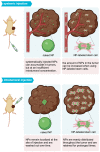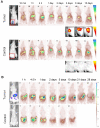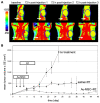Tumor-tropic Trojan horses: Using mesenchymal stem cells as cellular nanotheranostics
- PMID: 38169524
- PMCID: PMC10758060
- DOI: 10.7150/thno.90187
Tumor-tropic Trojan horses: Using mesenchymal stem cells as cellular nanotheranostics
Abstract
Various classes of nanotheranostics have been developed for enhanced tumor imaging and therapy. However, key limitations for a successful use of nanotheranostics include their targeting specificity with limited off-site tissue accumulation as well as their distribution and prolonged retention throughout the entire tumor. Due to their inherent tumor-tropic properties, the use of mesenchymal stem cells (MSCs) as a "Trojan horse" has recently been proposed to deliver nanotheranostics more effectively. This review discusses the current status of "cellular nanotheranostics" for combined (multimodal) imaging and therapy in preclinical cancer models. Emphasis is placed on the limited knowledge of the signaling pathways and molecular mechanisms of MSC tumor-tropism, and how such information may be exploited to engineer MSCs in order to further improve tumor homing and nanotheranostic delivery using image-guided procedures.
Keywords: Cancer; Image-guided therapy; Mesenchymal stem cells; Nanoparticles; Theranostics.
© The author(s).
Conflict of interest statement
Competing Interests: The authors have declared that no competing interest exists.
Figures











Similar articles
-
Trojan-Horse Diameter-Reducible Nanotheranostics for Macroscopic/Microscopic Imaging-Monitored Chemo-Antiangiogenic Therapy.ACS Appl Mater Interfaces. 2022 Feb 2;14(4):5033-5052. doi: 10.1021/acsami.1c22350. Epub 2022 Jan 19. ACS Appl Mater Interfaces. 2022. PMID: 35045703
-
Recent advances of polymeric nanoplatforms for cancer treatment: smart delivery systems (SDS), nanotheranostics and multidrug resistance (MDR) inhibition.Biomed Mater. 2023 Nov 27;19(1). doi: 10.1088/1748-605X/ad0b23. Biomed Mater. 2023. PMID: 37944188 Review.
-
Recent nanotheranostic approaches in cancer research.Clin Exp Med. 2024 Jan 19;24(1):8. doi: 10.1007/s10238-023-01262-3. Clin Exp Med. 2024. PMID: 38240834 Free PMC article. Review.
-
MRI tracking of polyethylene glycol-coated superparamagnetic iron oxide-labelled placenta-derived mesenchymal stem cells toward glioblastoma stem-like cells in a mouse model.Artif Cells Nanomed Biotechnol. 2018;46(sup3):S448-S459. doi: 10.1080/21691401.2018.1499661. Epub 2018 Sep 8. Artif Cells Nanomed Biotechnol. 2018. PMID: 30198338
-
A Trojan horse biomimetic delivery strategy using mesenchymal stem cells for PDT/PTT therapy against lung melanoma metastasis.Biomater Sci. 2020 Feb 21;8(4):1160-1170. doi: 10.1039/c9bm01401b. Epub 2019 Dec 18. Biomater Sci. 2020. PMID: 31848537
Cited by
-
Harnessing the Therapeutic Potential of Mesenchymal Stem Cells in Cancer Treatment.Adv Pharm Bull. 2024 Oct;14(3):574-590. doi: 10.34172/apb.2024.052. Epub 2024 Jun 22. Adv Pharm Bull. 2024. PMID: 39494266 Free PMC article. Review.
-
Mesenchymal Stem Cell Membrane-Derived Composite System for Enhancing the Tumor Treatment Efficacy of Metal-Organic Framework Nanoparticles.IET Nanobiotechnol. 2024 Dec 5;2024:1069307. doi: 10.1049/nbt2/1069307. eCollection 2024. IET Nanobiotechnol. 2024. PMID: 39669228 Free PMC article.
-
Trojan Horse Delivery Strategies of Natural Medicine Monomers: Challenges and Limitations in Improving Brain Targeting.Pharmaceutics. 2025 Feb 20;17(3):280. doi: 10.3390/pharmaceutics17030280. Pharmaceutics. 2025. PMID: 40142943 Free PMC article. Review.
-
Harnessing the potential of hydrogels for advanced therapeutic applications: current achievements and future directions.Signal Transduct Target Ther. 2024 Jul 1;9(1):166. doi: 10.1038/s41392-024-01852-x. Signal Transduct Target Ther. 2024. PMID: 38945949 Free PMC article. Review.
-
Single Mesenchymal Stromal Cell Migration Tracking into Glioblastoma Using Photoconvertible Vesicles.Nanomaterials (Basel). 2024 Jul 17;14(14):1215. doi: 10.3390/nano14141215. Nanomaterials (Basel). 2024. PMID: 39057891 Free PMC article.
References
-
- Chen X, Wong S. Cancer Theranostics: Elsevier Science; 2014.
-
- Wong XY, Sena-Torralba A, Álvarez-Diduk R, Muthoosamy K, Merkoçi A. Nanomaterials for Nanotheranostics: Tuning Their Properties According to Disease Needs. ACS Nano. 2020;14:2585–627. - PubMed
Publication types
MeSH terms
Grants and funding
LinkOut - more resources
Full Text Sources
Medical

